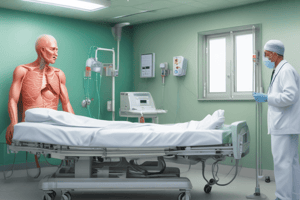Podcast
Questions and Answers
What is the primary purpose of informed consent?
What is the primary purpose of informed consent?
- To expedite the decision-making process
- To provide legal protection for practitioners
- To document patient history comprehensively
- To ensure patients are informed before procedures (correct)
Which step follows the identification of danger in the DRABC protocol?
Which step follows the identification of danger in the DRABC protocol?
- Assessment of breathing
- Airway management
- Evaluating circulation
- Checking for response (correct)
How does hyperventilation affect blood gas levels?
How does hyperventilation affect blood gas levels?
- Increases oxygen and decreases carbon dioxide (correct)
- Has no effect on blood gas levels
- Increases carbon dioxide and decreases oxygen
- Balances oxygen and carbon dioxide levels
What is the normal range for respiration in breaths per minute?
What is the normal range for respiration in breaths per minute?
Which component is not part of the respiratory system?
Which component is not part of the respiratory system?
What does DRABC stand for?
What does DRABC stand for?
What is the normal range of breaths per minute?
What is the normal range of breaths per minute?
Informed consent is the least important aspect before proceeding to any examination or procedures.
Informed consent is the least important aspect before proceeding to any examination or procedures.
The normal range for systolic blood pressure is _____?
The normal range for systolic blood pressure is _____?
What affects blood gas level in the body?
What affects blood gas level in the body?
Flashcards are hidden until you start studying
Study Notes
Informed Consent
- Essential prerequisite before conducting any examination or procedure.
- Should be performed whenever possible to ensure patient understanding and agreement.
DRABC Sequence
- D: Danger - Assess the environment for any hazards.
- R: Response - Check responsiveness of the individual.
- A: Airway - Ensure the airway is clear for breathing.
- B: Breathing - Verify the presence of effective breathing.
- C: Circulation - Assess circulation status.
- The combination of breathing and circulation is critical for delivering oxygen to organs, vital for life.
Breathing (Respiratory) System
- Composed of the airway (respiratory tract), gas exchange units (air sacs), rib cage, and respiratory muscles.
- Normal breathing rate ranges from 12 to 18 breaths per minute.
- Conditions like hyperventilation (excessive breathing) and hypoventilation (inadequate breathing) can disrupt blood gas levels, affecting oxygen and carbon dioxide balance.
Circulatory (Cardiovascular) System
- Blood pressure is a key indicator of cardiovascular health.
- Normal blood pressure range includes systolic values (upper measurements) which are yet to be specified in detail.
Informed Consent
- Essential prerequisite before conducting any examination or procedure.
- Should be performed whenever possible to ensure patient understanding and agreement.
DRABC Sequence
- D: Danger - Assess the environment for any hazards.
- R: Response - Check responsiveness of the individual.
- A: Airway - Ensure the airway is clear for breathing.
- B: Breathing - Verify the presence of effective breathing.
- C: Circulation - Assess circulation status.
- The combination of breathing and circulation is critical for delivering oxygen to organs, vital for life.
Breathing (Respiratory) System
- Composed of the airway (respiratory tract), gas exchange units (air sacs), rib cage, and respiratory muscles.
- Normal breathing rate ranges from 12 to 18 breaths per minute.
- Conditions like hyperventilation (excessive breathing) and hypoventilation (inadequate breathing) can disrupt blood gas levels, affecting oxygen and carbon dioxide balance.
Circulatory (Cardiovascular) System
- Blood pressure is a key indicator of cardiovascular health.
- Normal blood pressure range includes systolic values (upper measurements) which are yet to be specified in detail.
Studying That Suits You
Use AI to generate personalized quizzes and flashcards to suit your learning preferences.




